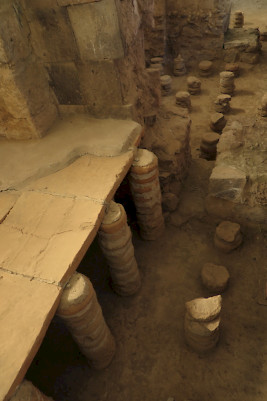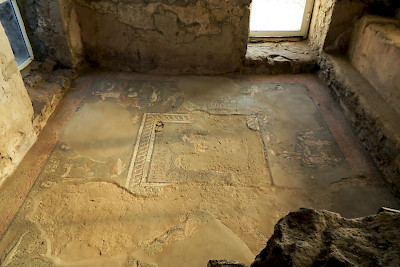Garni, Bathhouse
Gorneae: fortress in eastern Armenia, modern Garni.

To the north of Garni's famous temple are the remains of a bathhouse, which was built with materials similar to those used in the nearby palace, suggesting that the bathhouse dates to the third century CE as well. A mosaic floor may very well date to this age. There was a Roman-style floor heating ("hypocaustum"), which means that the floor was laid on little columns made of bricks; the heat from an oven could be circulating underneath the floor.
There is nothing exceptional about this, but there is an interesting mosaic at the entrance of the building. It consists of a small square inside a larger frame, which is decroated with all kinds of aquatic beings: a dolphin, oysters, and fish, but also Nereids, fishermen casting nets, sailors. In short, everything that people in Armenia never witnessed in real life. Still, the representations are quite realistic, suggesting that the makers of the mosaic were from a Mediterranean city (e.g., Antioch). We can read words like Seaside, Beauty, Depth, Serenity, and can see (aquatic) mythological figures like Thetis, Eros ("love"), Pothos, Peleus, Glaucus.

The inner square is what really makes this interesting: here we see Thalassa ("Sea") and Oceanus, two deities of the sea, and an inscription:
μηδέν λαβόντες ηργασάμεθα
which means
Without pay, we have been working.
Although we can understand these Greek words, we do not understand their meaning. It is possible that the makers of the mosaic had a quiet revenge on an employer who did pay as promised. Alternatively, the mosaic makers have documented that their work was done with love and passion, for someone they appreciated very much.